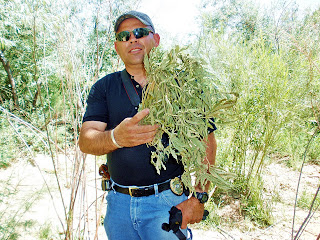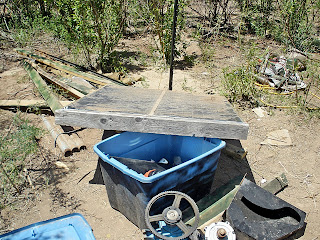 By John Larson
By John LarsonSOCORRO – In what may be the largest marijuana bust in New Mexico history, officers from six agencies working together confiscated an estimated ton of marijuana plants from three areas along the Rio Grande.
“At a minimum, there were fifteen hundred stalks brought out,” Socorro police detective Richard Lopez said.
Leading the raids was the Socorro Police Department, with assistance from the Socorro County Sheriff, New Mexico State Police, New Mexico National Guard Eradication Unit, the Bureau of Reclamation, and the Region 7 Drug Task Force.
According to a Bureau Of Land Management official, the site has been under surveillance for several weeks.
After the plantation was discovered - by researchers studying the Southwestern Willow Flycatcher in the riverine area - about two months ago, it was put under surveillance in hopes of making an arrest.
“It was decided that we would go ahead and secure the site last Saturday morning (June 19), and at least remove the plants before their harvest time,” Lopez said. “There were up to 30 officers on the initial raid at five o’clock in the morning.”
Similar operations were conducted at two other plantations; one five miles south of Bosquecito and the other 10 miles south of San Marcial. Some of the marijuana stalks were as high as eight feet, planted in small plots throughout the undergrowth. Law enforcement officers and members of the New Mexico National Guard spent most of the day Saturday locating and cutting down the plants.
Some of the marijuana stalks were as high as eight feet, planted in small plots throughout the undergrowth. Law enforcement officers and members of the New Mexico National Guard spent most of the day Saturday locating and cutting down the plants.
Chief Deputy Shorty Vaiza said the growers had invested “anywhere from $20,000 to $30,000 in equipment in the elaborate set up on the three locations.
Confiscated were solar panels, generators, hundreds of yards of pipes and hoses, and personal belongings.
The growers were running an elaborate drip system for the plants which was spread out among the trees and underbrush. Solar panels charged marine batteries which powered the generators for motors and pumps for the drip irrigation system. The drip system was even hooked up to an electronic timer.
He said the area near the river is already humid, and with the drip system the plants were able to thrive.
“They lost all of that, in addition to the possibly between $750,000 to a million dollars worth of marijuana plants we took out,” he said. “This was no small time undertaking.”
Montoya said that although the operation was stopped, no arrests were made.
“There was one person at the site and he quickly disappeared into the woods as soon as officers arrived,” Montoya said.
Officers searched for the suspect for about two hours, he said.
Detective Richard Lopez said at one point the male suspect was only 30 to 40 feet in front of them,
Along the same section of the river were two other sites, each with two camping sites complete with tents small hotplates, grills, and food.
“The second site at Bosquecito was cleared out, then the one south of San Marcial,” Lopez said. “Those other two sites were smaller.”
Detective Rocky Fernandez estimated the growers had been operating at the Escondida site for possibly seven years.
“We can assume the two other sites had been there about the same length of time,” Fernandez said. “And there could be several other sites between here and [Elephant Butte Reservoir].”
Law enforcement personnel and civilian volunteers were at the Escondida location until about midnight, collecting evidence and cutting and hauling out marijuana stalks.
The New Mexico National Guard has an eradication unit, which used a Blackhawk helicopter to remove the plants from the dense woods. The marijuana stalks were delivered by the helicopters to the airport, and then transported to the police department for processing.
The marijuana stalks were delivered by the helicopters to the airport, and then transported to the police department for processing.
Tuesday the marijuana was spread out across the police department parking lot to dry.
“We had to secure the plants for evidence, and sitting in a room rotting was not going to secure it. It had to be dried,” he said.
He said processing the evidence was too much for the officers to handle by themselves, from the Escondida site to the police parking lot.
“We got help from different parts of the community, who went above and beyond what was needed to be done,” Lopez said. “Credit goes out to the Socorro Electric Cooperative, who brought a chipper and trucks and helped us haul it, and volunteers from the BLM who helped to pull the marijuana.
“Civilian volunteers like Peter Trujillo came out to help haul the stuff in their trucks. Sonic employees brought us burritos and drinks. One of our dispatchers, Carlos Valenzuela, and even our mechanic, Tom Stidstone, came out on their own time, not asking for anything in return. Just to help
“It makes you proud to live in Socorro. With all the bad there is, there’s also a lot of good,” Lopez said.
Pictures (from top):
Sheriff Philip Montoya and Chief Deputy Shorty Vaiza insepct two heaps of marijuana plants, ready for transporting by the National Guard’s Blackhawk helicopter.
Police Detective Rocky Fernandez leads the way down one of the many narrow trails leading to the camping area in the marijuana plantation.
A quickly abandoned campsite. Investigators were able to collect much evidence, which they believe will lead to the operators of the three marijuana plantations.
Detective Fernandez explains how unused plants were used for mulch for newer plots.
One of the solar panels used to power the drip system and other equipment.
Police Officer Brandi Perkins and city employee Tom Stidstone collect dried marijuana from the police parking lot Tuesday afternoon.











